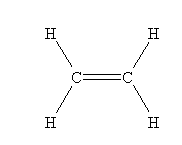to draw lewis dot diagrams:
- total all valence electrons in atoms
- identify the element that can form the most bonds. this will be the central atom
- draw bonds between atoms as a line (represents 2 electrons)
- any electrons not part of a bond are lone pairs around the atom
- check to make sure each atom has a full octet
example
ammonia water and ethane

C2H4

heres a extremely educational video!!






